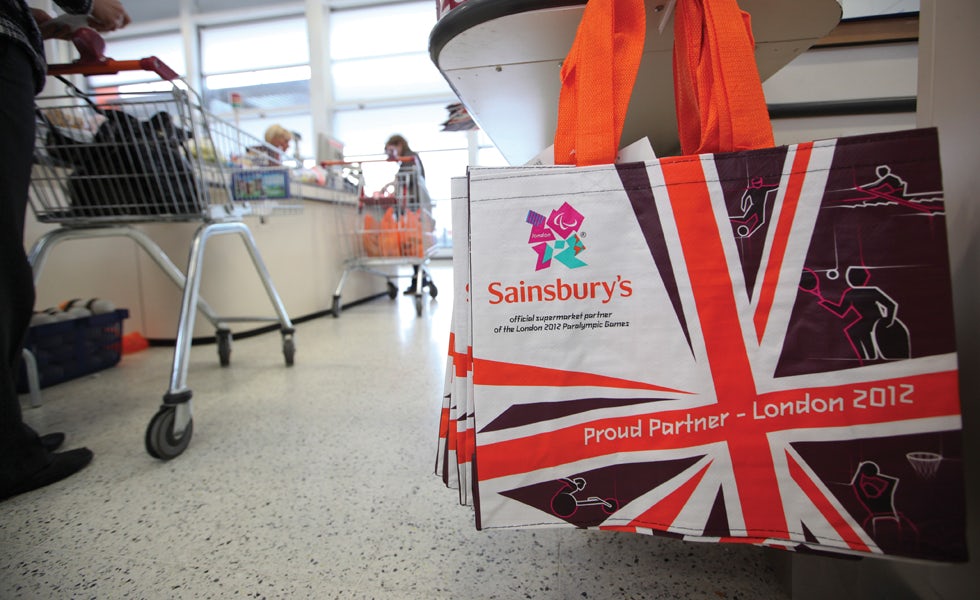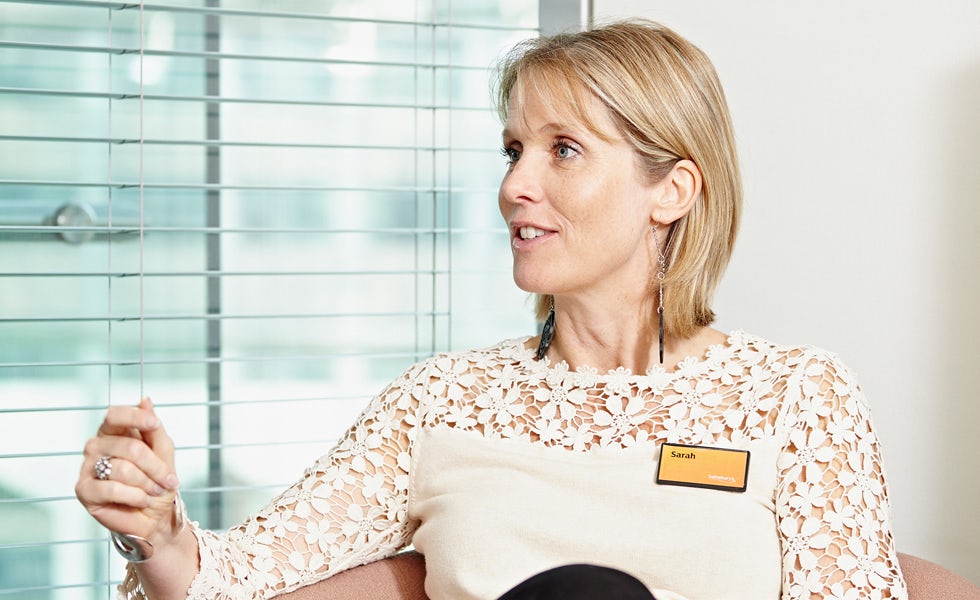Inside Sainsbury’s
Marketing Week Brand of the Year Sainsbury’s has been on a high after 2012, its ‘year like no other’. Learn how it intends to maintain momentum to stay ahead.

Above: Sainsbury’s bananas are the reason it has recently locked horns with Tesco, with its advertising claiming the ones it sells are Fairtrade, whereas Tesco’s are not. Food provenance is something Sainsbury’s is promoting, having launched a campaign claiming ‘same price, different values’
Above: Sainsbury’s bananas are the reason it has recently locked horns with Tesco, with its advertising claiming the ones it sells are Fairtrade, whereas Tesco’s are not.
Also in this story:
Sarah Warby, marketing director of Sainsbury’s, is in a buoyant mood. When Marketing Week meets her, Sainsbury’s is in the middle of its Summer Series – an athletics event celebrating athletes and para-athletes from last year’s Olympics and Paralympic Games; Sainsbury’s was a major sponsor of the Paralympics.
Warby is in ebullient mood as she discusses how the company is continuing to support para-sport in the run up to the 2018 Olympic Games in Rio, Brazil; she is on the Paralympic Legacy Advisory Group run by the Cabinet Office.
As part of the event, children that are part of Sainsbury’s Active Kids and live in the Olympic borough of Newham ran a mile and the retailer made a donation for each mile that they did.
The Anniversary Games – the part of this year’s event that was held at the Olympic Park – was held in July and sponsored by the supermarket.
“We are ridiculously excited about the Anniversary Games,” Warby said when we spoke to her. “We are back in the Olympic stadium, for the first time since the Paralympics. The non-disabled Games sold out in about 75 minutes and the [parasport Games] sold out almost as fast, which is awesome. We have shown the world something.”
The Active Kids partnership encourages children to get into sport and has been running for the past nine years. It has recently donated £1m to train teachers to help children take up sport, irrespective of their ability.
“People are increasingly concerned about food provenance and the sourcing of their food and that’s going to get more important”
The brand has had an amazing year. After sponsoring the Paralympic Games in 2012, which lead to an increase in sales of 5.6 per cent in the 12 weeks to September, this year it has been the only major multiple to increase market share, gaining 3.8 per cent in the year to 7 July, according to the latest Kantar Worldpanel figures.
Sainsbury’s also avoided the horse meat scandal, which rocked competitors Tesco and Asda, with sales appearing to have benefited from people switching to its brand, according to spring figures. It also picked up the prestigious Brand of the Year trophy at Marketing Week’s Engage Awards, run in association with YouGov.
So the challenge now is how to keep up the momentum. Sainsbury’s is choosing key moments in the calendar to launch big pushes to help customers. In January, it ran its ‘Make the most of your roast,’ campaign, which encouraged families to buy a bigger joint of meat and suggested recipes for using leftovers.
“When we go to town [with marketing] that is when we are being helpful,” says Warby. “It’s not as grand as the fireworks of the Paralympics but our customers tell us that [these initiatives] are valued.” The marketing team came up with the idea, which was turned into reality by Sainsbury’s product developers and chefs.
Helpfulness is something that Warby returns to time and again. “We like to have lots of news on the business, things such as our pharmacy and health and British Sourcing, that is the drumbeat of our business. We then try to overlay that by being helpful, because what this business has is 144 years of helping customers run their homes.”
However, the retailer also has a problem with the perception that it is more expensive than its competitors, which it started to deal with in September 2011 when it launched the strapline ‘Live well for less’ to replace ‘Try something new today’. For the past year, it has been pushing Brand Match, where it will match the price of branded goods at Asda or Tesco or give people a coupon for the difference, on shopping spend over £20.
“People do think we are more expensive than we actually are, which is not good. The lovely thing from a marketer’s point of view is the old cliché about what is marketing or advertising – it is the truth well told. So all I have to do is tell the truth.
“Brand Match illustrates how competitive our pricing is because more than half the coupons say: ‘your shop was cheaper here today’.” While loyal customers understand that Brand Match includes products on deal at the other supermarkets, not everybody gets it, admits Warby. “It’s our less loyal customers who don’t see [the coupons] as often and don’t necessarily realise it includes the deals. So they will see a great deal somewhere [else] and go there. I can understand that, but it’s a longer game.”

Warby also suggests that it will ramp up its Nectar activity, the UK’s biggest loyalty scheme that is run in partnership with Aimia. “I want to make [Nectar] unequivocally the most loved [scheme] as well as the biggest. That means getting people to enjoy the earning process. There is an element of sport and gaming about it.
“There is science underneath it but I want to give people more of the great feeling of redeeming points.”
This month has seen the supermarket go one step further in the price war, asking for an independent review of the Advertising Standard Authority’s (ASA) decision not to uphold its complaint against Tesco’s price claims. Tesco’s Price Promise compares own-label products where an equivalent is sold by a rival whereas Sainsbury’s Brand Match only talks about branded goods. The ASA rejected a complaint Sainsbury’s had made that Tesco’s advertising was misleading because it does not make like for like comparisons.
While it waits for the independent reviewer’s verdict, it has launched ads promoting the provenance of its food using the line: ‘Same price, different values,’ explaining, for example, that its bananas are Fairtrade unlike Tesco’s bananas. These join other ads about the origins of its Basics range of food, including free-range eggs and sustainably-sourced fish fingers.
Food provenance, along with price, will be further highlighted by the company into next year, says head of brand communications Mark Given. “One of the trends [we see] is that in the UK it is [still] difficult for our customers in terms of being a family with a constrained budget.

“We also know that people are increasingly concerned about provenance and the sourcing of their food and that is only going to get more important,” he says. How the retailer sources its food is part of its 20×20 Sustainability Plan, which was announced last year. One aim is to double the amount of British food it sells and make sure its own label products will not contribute to global deforestation by 2020.
Warby recently revealed that marketing is being planned three years ahead as opposed to annually and Given explains that that means working closer together as a team.
“We are trying to be joined up as a marketing leadership team and have a clear, consistent view of what the future looks like, based on customer understanding and what we need to deliver commercially.
“There is that flex between the short- and long-term and making sure we are executing brilliantly this week or month, for example. As a 144-year-old brand, we need to almost be writing the next chapter and have a longer term plan in terms of what we are famous for vis-a-vis our competition,” he says.
In terms of the competition, Sainsbury’s share of the market is neck and neck with Asda. In January this year, Sainsbury’s overtook Asda to become the second largest supermarket after Tesco. However, the latest Kantar Worldpanel figures have it in third place again with a share of 16.5 per cent compared to Asda’s 17 per cent and Tesco’s 30.1 per cent.
Although the supermarket’s sales have increased for an impressive 34 quarters in a row, it may need to do more to keep up with the competition in other ways. Some analysts have criticised it for being slow to market in the mobile industry, having launched Mobile By Sainsbury’s in a 50/50 joint venture with Vodafone last month. Ovum analyst Emeka Obiodu called it a ‘not being left behind move’.
“Insight is useful only if it is commercially viable and operationally feasible”
According to Warby, the late move into the mobile world is because it wanted to do it in the right way and one which represents its brand. “Our approach is always to learn and understand before we try to foist ourselves on a new category. We are not keen to white label something just because we can or because of our scale.
“We will happily run the risk of being a bit slower to market to listen to our customers and understand how this works in this category for them and what Sainsbury’s can bring to it.” It found that people wanted simple deals and helpful salespeople. “It is not revolutionary but it is mobile done through a Sainsbury’s lens. Whenever we do something new, if we can’t find the Sainsbury’s lens we will keep looking, we won’t just launch it anyway.”
Similarly, it does not rush towards Christmas in the same way as other companies. Sainsbury’s will start its campaign for the festive season after Armistice Day on 11 November. “We don’t think it is appropriate,” says Given, “We don’t think customers like starting Christmas earlier. There is something about holding back a bit that is not really debatable. We want to support the Poppy Appeal too and make sure it has a real focus in-store. That is above the commercial outcome, it is about the values [of the business].”
But when it comes to mobile, it may have missed out on a large chunk of the market already. Tesco Mobile, which is run as a joint venture with O2, launched 10 years ago and has 3 million customers.
Mobile and oher areas of non-food are a big part of the growth plans for Sainsbury’s – as with Tesco – and general merchandise is growing at twice the rate of food.
Sales (excluding fashion) went over the £1bn mark in February this year and it will have another boost in January 2014 when goods are reduced. “It is a really big time of year for general merchandise that doesn’t need that much above-the-line support because the products sell themselves.”

Warby adds that it held its annual Christmas in July event, as many brands do, to showcase what will be available over the festive period. Visitors were surprised that the company sells furniture and she admits that if someone lives near a big store they will be aware of it but those with small shop nearby will not.
She also admits the company buys in stock for the January sale, saying: “Coming into this business, it was interesting to learn that January sales are not when you clear out the stuff you couldn’t sell, it is when you buy new products for the sale.”
Warby joined Sainsbury’s from Heineken in January 2012, where she had spent eight years in marketing and innovation roles, including four as marketing director. She says her time in FMCG marketing helped her think like customers and consider whether something builds on a brand’s equity.
However, she and Given both say that working for a supermarket has opened their eyes to how quickly things can get done. Given says: “I spent 15 years in FMCG and when you come into retail you realise that the F [fast] in FMCG is a bit of a misnomer, when you see the speed that we have to work at. It is never a dull moment.”
He adds that having board members sit openly on the same floor as the marketing team means it is easy to communicate with them and that decisions are made quickly. Metrics are also measured keenly so the business can be reactive where necessary (see ’How Sainsbury’s approaches insight’). “It is so fast, so reactive we know exactly what A does versus B within several days of doing it, you can test things live,” explains Warby.
What she loves about it is the pace: “Try fast, fail fast, fix fast, get on with it, there’s nothing better.” And with that, she is off to move the brand into 2016 and beyond.
Figure focus
- 79 – BrandIndex Buzz score, versus 68.9 for Morrisons, 43.2 for Asda and 30.4 for Tesco*
- 150,000 – the number of employees at Sainsbury’s
- £20m – value of Sainsbury’s sponsorship of the Paralympics
- £180 – the potential annual value per customer of Nectar points collected when linked to Mobile By Sainsbury’s
- £680m – the 2012 sales of its own-label Tu range of clothing
- 20,000 – By 2020, 20,000 staff will have reached 20 years of service
Sources: Sainsbury’s, YouGov BrandIndex, Sunday Times.
*as at 19 August 2013






